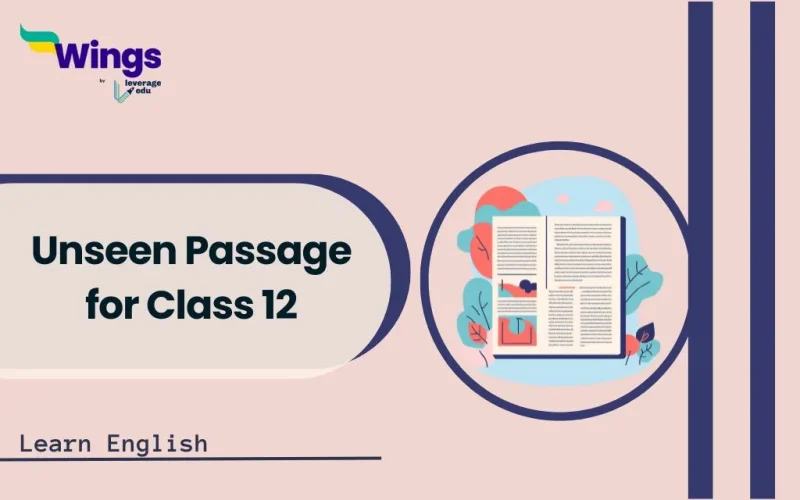In the academic journey of Class 12, mastering reading comprehension is crucial, particularly when it comes to unseen passages. These passages not only form a significant part of the English curriculum but also play a vital role in enhancing students’ analytical and interpretative skills.
As per the latest CBSE examination pattern, students will encounter two unseen passages and one poem in their board exams, collectively contributing to a substantial portion of their overall marks. Keep reading this blog post, as you will find several examples of unseen passages for Class 12 CBSE students.
This Blog Includes:
Unseen Passage for Class 12 with Answers
Here are five long examples of unseen passages for Class 12 CBSE students, along with questions and answers for each passage.
Passage 1: The Impact of Technology on Society
In the modern world, technology plays a pivotal role in shaping our daily lives. From smartphones to artificial intelligence, technological advancements have transformed how we communicate, work, and interact with one another. The advent of the internet has revolutionised access to information, allowing individuals to connect globally in real time. This connectivity has fostered a sense of community and collaboration, breaking down geographical barriers.
However, the impact of technology is not solely positive. The rise of social media has led to concerns about privacy and mental health. Many individuals experience anxiety and depression due to the pressure to maintain an online persona. Additionally, the digital divide remains a significant issue; not everyone has equal access to technology, leading to disparities in education and employment opportunities.
As society continues to evolve alongside technology, it is crucial to find a balance that maximises benefits while minimising drawbacks. Education systems must adapt to prepare students for a tech-driven world, emphasising digital literacy and critical thinking skills.
Questions:
- What role does technology play in modern society, according to the passage?
- What are some positive impacts of technology mentioned?
- What concerns are raised regarding social media?
- What is the digital divide?
- How should education systems adapt according to the passage?
Answers:
- Technology is pivotal in shaping daily lives by transforming communication, work, and interactions.
- The internet has revolutionised access to information and fostered global connectivity and collaboration.
- Concerns include privacy issues and mental health challenges related to maintaining an online persona.
- The digital divide refers to the disparity in access to technology among different populations, affecting education and employment opportunities.
- Education systems should emphasise digital literacy and critical thinking skills to prepare students for a tech-driven world.
Passage 2: Climate Change and Its Consequences
Climate change has emerged as one of the most pressing challenges facing humanity today. With rising global temperatures, shifting weather patterns, and increasing frequency of extreme weather events, the effects of climate change are becoming more evident. Scientists warn that if current trends continue, we could face catastrophic consequences, including widespread food shortages, loss of biodiversity, and increased health risks.
The primary driver of climate change is human activity, particularly the burning of fossil fuels which releases greenhouse gases into the atmosphere. Deforestation also contributes significantly by reducing the number of trees that can absorb carbon dioxide. To combat climate change, it is essential for governments, businesses, and individuals to take collective action.
Efforts such as transitioning to renewable energy sources, enhancing energy efficiency, and promoting sustainable practices can mitigate the impacts of climate change. Public awareness campaigns are also crucial in educating communities about their role in combating this global crisis.
Questions:
- What are some observable effects of climate change mentioned in the passage?
- What are the potential consequences if climate change trends continue?
- What human activities contribute significantly to climate change?
- What actions can be taken to combat climate change?
- Why are public awareness campaigns important?
Answers:
- Rising global temperatures, shifting weather patterns, and increased frequency of extreme weather events.
- Catastrophic consequences include food shortages, loss of biodiversity, and increased health risks.
- The burning of fossil fuels and deforestation are major contributors.
- Transitioning to renewable energy sources, enhancing energy efficiency, and promoting sustainable practices.
- They educate communities about their role in combating climate change and encourage collective action.
Passage 3: The Importance of Mental Health Awareness
Mental health awareness has gained significant traction in recent years as society recognises its importance in overall well-being. Mental health issues affect millions worldwide; however, stigma often prevents individuals from seeking help. This stigma can lead to feelings of isolation and despair among those struggling with mental health conditions.
Raising awareness about mental health is crucial for fostering understanding and empathy within communities. Educational programs can help dispel myths surrounding mental illness and encourage open discussions about emotional well-being. Furthermore, workplaces that prioritise mental health create supportive environments where employees feel safe discussing their challenges without fear of judgment.
Access to mental health resources is also essential for effective treatment. Governments should invest in mental health services that provide support for individuals in need. By promoting mental health awareness and resources, society can work towards breaking down barriers that hinder individuals from seeking help.
Questions:
- Why is mental health awareness important, according to the passage?
- What negative effects does stigma have on individuals with mental health issues?
- How can educational programs contribute to mental health awareness?
- What role do workplaces play in supporting mental health?
- What should governments do regarding mental health services?
Answers:
- It fosters understanding and empathy within communities while encouraging individuals to seek help without stigma.
- Stigma can lead to feelings of isolation and despair among those struggling with mental health conditions.
- They can dispel myths surrounding mental illness and promote open discussions about emotional well-being.
- Workplaces that prioritise mental health create supportive environments where employees feel safe discussing their challenges.
- Governments should invest in mental health services that provide adequate support for individuals in need.
Passage 4: The Role of Art in Society
Art has always played a vital role in society by reflecting cultural values and provoking thought. Through various forms—painting, music, literature—art serves as a medium for expression that transcends language barriers. It allows individuals to communicate emotions and experiences that might otherwise remain unspoken.
Moreover, art can inspire social change by highlighting injustices and giving voice to marginalised communities. Movements such as street art have emerged as powerful tools for activism, bringing attention to pressing societal issues like inequality and environmental degradation.
In addition to its social impact, art contributes significantly to individual well-being. Engaging with art—whether through creation or appreciation—can enhance emotional resilience, reduce stress levels, and foster a sense of belonging within communities.
As society continues to evolve, recognising the importance of art is crucial for nurturing creativity and promoting cultural dialogue.
Questions:
- What roles does art play in society, according to the passage?
- How does art serve as a medium for expression?
- What impact can art have on social issues?
- How does engaging with art benefit individuals?
- Why is it important for society to recognise the value of art?
Answers:
- Art reflects cultural values, provokes thought, communicates emotions, inspires social change, and enhances individual well-being.
- It transcends language barriers allowing individuals to express emotions and experiences that might otherwise remain unspoken.
- Art can highlight injustices and give voice to marginalised communities; movements like street art serve as tools for activism.
- Engaging with art enhances emotional resilience, reduces stress levels, and fosters a sense of belonging within communities.
- Recognising art’s importance nurtures creativity and promotes the cultural dialogue necessary for societal evolution.
Passage 5: The Future of Renewable Energy
As concerns over climate change intensify, renewable energy sources have emerged as essential components in creating a sustainable future. Solar power harnesses sunlight through photovoltaic cells or solar thermal systems; wind energy captures kinetic energy from wind using turbines; hydroelectric power utilises flowing water; while geothermal energy taps into heat from beneath the Earth’s surface.
Transitioning from fossil fuels to renewable energy not only reduces greenhouse gas emissions but also promotes energy independence by diversifying energy sources. Governments worldwide are investing heavily in renewable technologies through subsidies and incentives aimed at reducing initial costs for consumers while encouraging innovation within the sector.
Despite these advancements, challenges remain—such as storage capabilities for intermittent sources like solar and wind—and infrastructure development needs significant investment. However, with continued research and commitment from both public entities and private sectors alike, renewable energy holds promise for addressing.
Questions:
- What are some examples of renewable energy sources mentioned in the passage?
- Why is transitioning from fossil fuels important, according to the passage?
- How are governments supporting renewable energy technologies?
- What challenges does renewable energy face according to the passage?
- What potential does renewable energy hold for the future?
Answers:
- Solar power, wind energy, hydroelectric power, and geothermal energy are examples provided.
- It reduces greenhouse gas emissions and promotes energy independence by diversifying energy sources.
- Governments invest through subsidies and incentives aimed at reducing initial costs for consumers while encouraging innovation.
- Challenges include storage capabilities for intermittent sources like solar/wind energy and significant investment needs for infrastructure development.
- Renewable energy holds promise for addressing global energy demands sustainably while protecting the planet for future generations through continued research and commitment from various sectors.
Also Read: Difference Between CA and CS
Unseen Passage for Class 12 with Factual CBSE with Answers
In this section, we have a factual unseen passage for Class 12 CBSE followed by questions and answers. Read this English comprehension passage and try to answer the questions while preparing for your English term, pre-board, or board exam.
The Importance of Biodiversity
Biodiversity refers to the variety of life found on Earth, encompassing the diversity of species, ecosystems, and genetic variations within species. It plays a crucial role in maintaining ecological balance and ensuring the sustainability of natural resources. Healthy ecosystems, rich in biodiversity, provide essential services such as clean air and water, pollination of crops, and climate regulation.
However, biodiversity is under severe threat due to human activities. Deforestation, pollution, climate change, and habitat destruction are leading to a rapid decline in species populations worldwide. According to the United Nations, approximately 1 million species are currently at risk of extinction. This loss not only affects the environment but also has significant implications for human health and livelihoods.
Conserving biodiversity is essential for sustaining life on Earth. It requires concerted efforts from governments, organisations, and individuals. Protected areas such as national parks and wildlife reserves are vital for preserving habitats and species. Additionally, sustainable practices in agriculture, forestry, and fisheries can help mitigate the impact of human activities on ecosystems.
Public awareness and education about the importance of biodiversity are also crucial. By understanding the interconnectedness of life forms and their roles in the ecosystem, individuals can make informed choices that promote conservation efforts. Ultimately, protecting biodiversity is not just about saving species; it is about ensuring a healthy planet for future generations.
Questions:
- What does biodiversity encompass?
- Why is biodiversity important for ecological balance
- What are some threats to biodiversity mentioned in the passage?
- How many species are currently at risk of extinction according to the United Nations?
- What measures can be taken to conserve biodiversity?
Answers:
- Biodiversity encompasses the variety of life on Earth, including the diversity of species, ecosystems, and genetic variations within species.
- Biodiversity maintains ecological balance by providing essential services such as clean air and water, pollination of crops, and climate regulation.
- Threats include deforestation, pollution, climate change, and habitat destruction.
- Approximately 1 million species are currently at risk of extinction.
- Measures include establishing protected areas like national parks and wildlife reserves, promoting sustainable practices in agriculture, forestry, and fisheries, and enhancing public awareness about biodiversity.
Also Read: Ways to Improve Reading Speed and Comprehension
Unseen Passage for Class 12 (PDF)
Now that you have gone through all the samples for the unseen passage for Class 12 CBSE students, let us now look at this bonus unseen passage, which we have prepared for you in this PDF. You can easily save and download it for future usage.
Find Related Blogs here!
FAQs
An unseen passage is a short text or paragraph that students haven’t read before. It is followed by a set of questions to test reading comprehension, vocabulary, and analytical skills.
The unseen passage section usually carries 10 to 12 marks in the Class 12 English exam, depending on the board and paper pattern.
Questions can be objective, short answer, or vocabulary-based, including synonyms, antonyms, true/false, and inference-based questions.
We hope this blog on Unseen Passage for Class 12 CBSE was informative and helped you improve your English language skills. You can also follow the Learn English page of Leverage Edu for more exciting and informative blogs related to English grammar and the English language.
-
very much effective topics are given.these are use ful also for articles.
-
Hey Rakshita Tanwar,
Glad to know your found our blog useful.You can follow the Learn English page of Leverage Edu for more such articles. If you are interested in studying abroad, you can call us at: +919821527751
-
 One app for all your study abroad needs
One app for all your study abroad needs















 60,000+ students trusted us with their dreams. Take the first step today!
60,000+ students trusted us with their dreams. Take the first step today!


2 comments
very much effective topics are given.these are use ful also for articles.
Hey Rakshita Tanwar,
Glad to know your found our blog useful.You can follow the Learn English page of Leverage Edu for more such articles. If you are interested in studying abroad, you can call us at: +919821527751